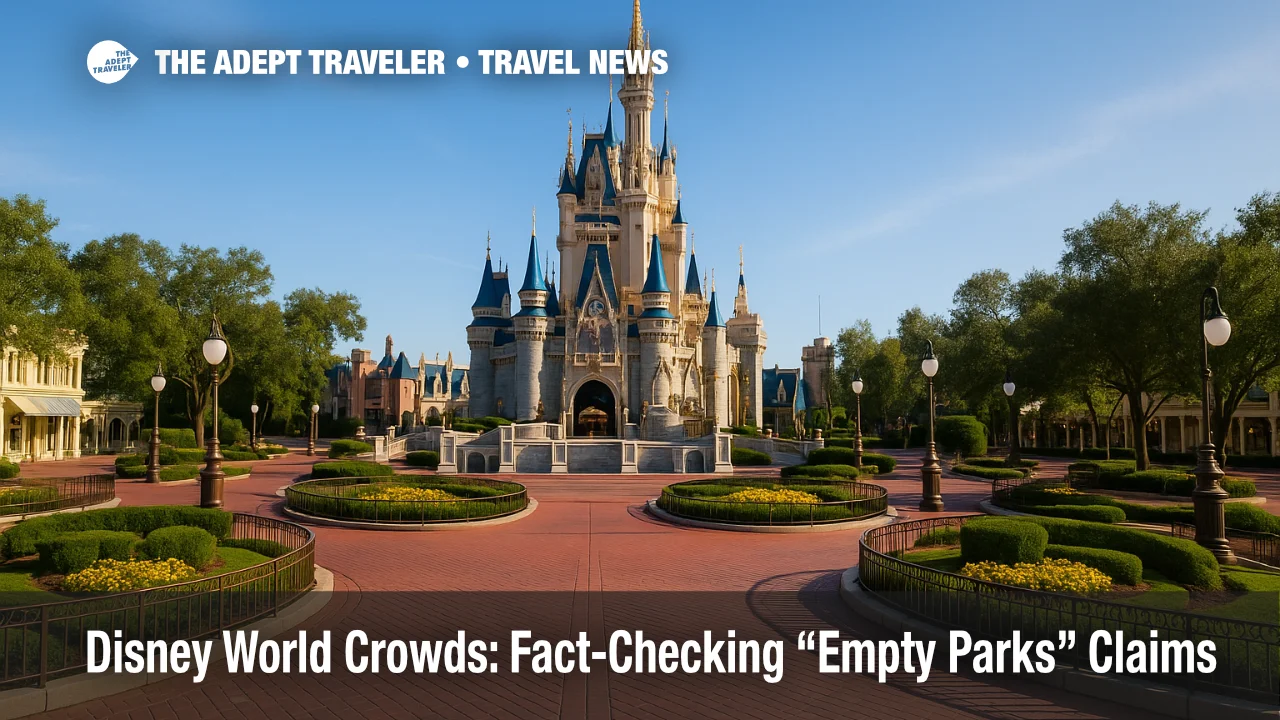Disney World crowds: fact-checking those "empty parks" claims

Reports claiming Walt Disney World is "empty" are circulating again, but the numbers tell a different story. September does bring softer attendance as schools resume and Florida heat peaks, reducing average waits across the resort. However, Disney's latest earnings show the Experiences division remains resilient, and third-party wait-time trackers reflect seasonal patterns rather than a collapse. Here is what current data suggests about crowd levels, costs, and timing your visit.
Key Points
- Why it matters: Viral "empty park" claims can distort traveler planning and lead to poor timing decisions.
- Travel impact: September usually has some of the shortest waits, then crowds return for Halloween and fall breaks.
- What's next: Expect higher demand beginning late September, plus event-driven spikes through October and November.
- Late summer 2025 posted the year's lowest average waits, consistent with historical shoulder-season trends.
- Disney's Experiences segment remains profitable, indicating demand stability despite periodic soft spots.
Snapshot
Social posts and tabloid headlines suggest Walt Disney World is deserted. In reality, September is traditionally one of the lightest months for crowds, especially on weekdays after Labor Day. Resort-wide average waits near 30 minutes are common in early to mid-September, according to independent aggregators that compile posted queue times across Magic Kingdom, EPCOT, Disney's Hollywood Studios, and Disney's Animal Kingdom. Those levels typically rise toward the end of the month as Halloween events and fall breaks begin. Disney's most recent quarterly results also point to a healthy Experiences segment, undercutting the idea of a broad tourism "collapse." Travelers should plan for variable conditions rather than assume empty parks.
Background
Every late summer, Florida's heat, afternoon storms, and back-to-school calendars push demand lower, especially before major fall events start. That seasonal lull shows up in wait-time datasets, which approximate crowd intensity by averaging posted queue times across headline attractions. Independent trackers highlight August and early September as the slowest weeks of the year, followed by a step-up beginning in late September and another lift around Columbus Day week. These patterns are long-standing and do not indicate a structural decline on their own. Meanwhile, Disney's Experiences division performance in recent quarters reflects strong pricing power and steady per-capita spending, even as attendance oscillates with weather, events, and regional economics. Interpreting a quiet weekday in September as a demand crisis ignores decades of seasonality at Orlando's theme parks.
Latest Developments
September slowdown aligns with data, not doom
Fresh snapshots from crowd-tracking sites show resort-wide averages in the low-30-minute range during early to mid-September, which historically ranks among the best times to visit. Touring-plan analytics and daily "data dump" posts in mid-September show predictions largely matching observed levels, with some days even quieter than expected. Disney-focused analysts also flagged August and early September 2025 as the slowest stretch of the year, consistent with 2024 patterns. On the corporate side, The Walt Disney Company's fiscal third-quarter report, released August 6, 2025, cited gains in total segment operating income and reiterated strength in the Experiences business, countering narratives of a systemic downturn. Taken together, the evidence supports a standard shoulder-season dip, followed by rising demand heading into Halloween parties, EPCOT food-and-wine evenings, and fall-break periods. Plan accordingly.
Analysis
Anecdotes and camera angles can make a plaza look deserted, especially during rope-drop dispersal, afternoon storms, or at attractions undergoing downtime. That is why wait-time-derived crowd indices matter; they smooth out moment-to-moment noise by averaging posted queues across the day and across parks. This year's readings confirm the typical pattern, with August and early September posting the lowest averages, then a staircase into late September as seasonal events, group travel, and fall breaks kick in. None of the reputable datasets indicate a broad collapse in demand. Meanwhile, Disney's Experiences results tie back to per-capita spend, hotel occupancy, and event-driven revenue, which can offset or even outpace modest attendance shifts.
For travelers, the actionable takeaway is timing. If you want shorter lines, target weekdays in early September or similar shoulder windows, accept the heat, and arrive early with a midday break. If you prefer fuller entertainment schedules and extended hours, late September through November brings livelier parks but longer waits and premium pricing for after-hours events. Budget pressures are real, and some families will choose alternatives like cruises or regional parks, but that rebalancing has not emptied Orlando. Use verified crowd calendars and official operating schedules, not viral claims, to shape park-day strategies, dining reservations, and Lightning Lane purchases. Smart timing still beats sensational headlines.
Final Thoughts
Travelers should read "empty parks" headlines with caution. The data shows a seasonal slowdown, not a free fall, and Disney's financials remain consistent with a healthy Experiences segment. If lower waits are your priority, aim for early to mid-September weekdays, then expect crowds to build quickly for Halloween and fall breaks. Those patterns align with long-running school calendars, weather, and event schedules rather than abrupt sentiment shifts. Plan with real numbers, stay flexible with afternoon storms, and book time-sensitive experiences early. That approach will serve you far better than viral posts, especially when you are optimizing around Disney World crowds.
Sources
- The Walt Disney Company Reports Third Quarter and Nine Months Earnings for Fiscal 2025, The Walt Disney Company
- Disney's Q3 FY25 Earnings: Executive Commentary and Announcements, The Walt Disney Company
- Walt Disney World Wait Times, Thrill-Data
- 2025 Walt Disney World Crowd Calendar, Thrill-Data
- Disney Data Dump, September 17, 2025, TouringPlans
- Off-Season Crowd Slowdown at Disney World, Disney Tourist Blog
- Theme Index Report 2023, TEA/AECOM
